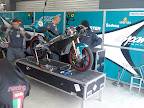That brings up a (slightly) different part of the subject.
There are a few engineers who chose the point where there balance the crank
i.e what position the crankpin is at (looking at it from the taper sider, what degree is it at.....12 oclock, one oclock, sometimes two oclock.
It depends on who you talk to. It seems common practice that MOST people balance it at the 12 oclock position, yet having ridden bikes with both approaches, I have never noticed a difference.
I suspect it is because a single cylinder vibrates so much anyway, that a slight change in either direction is unnoticed.
This one was checked in the 12 oclock position.
As a matter of interest with the subject of getting the correct factor on the crank I made (52%) I would have to add 35gm's to the counter weight (webs) or remove weight from the crank pin. (drilling the centre),
I suspect that would be courting disaster though.
Other than speedpro's jig set up, there is also dynamic balancing....... the advantage of dynamic balancing, is that, for example, on the "static" set up (per Speedpro's example) you can only add (or subtract) weight from the webs in an approximate fashion...... (you just have to do your best to add/remove it as evenly as possible from each side of the webs.
If you don't take/add the weight evenly from each side of the web, you get "twist" in the webs as they spin (because they in turn are out of balance with each other)
This is what is termed "rocking couple"
Having a dynamic balancer, enables you (via computer controlled measurements) to remove/add weight as is needed, evenly from the webs.
It doesn't make any difference to the overall balance factor, but if the webs are badly out of balance with each other, the result is "twisting" of the webs, and before too long, the webs simply "twist off"
I have seen this on a very high performance engine (with extremely light crank)
It is also a good idea to put your flywheel on when measuring your balance.... be it static or dynamic
If you take it to a machine shop now days, chances are they will have a dynamic balancer, static is quite labour intensive.
Kind of like a tyre balancing machine compared to an axle stand, the result is more or less the same, but the machine does it faster and more accurately, as well as the operator needs less training.






 Reply With Quote
Reply With Quote






Bookmarks